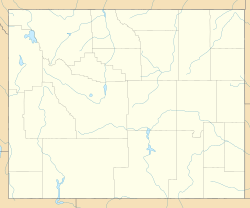St. Luke's Episcopal Church (Buffalo, Wyoming) facts for kids
Quick facts for kids |
|
|
St. Luke's Episcopal Church
|
|
 |
|
| Location | 178 S. Main, Buffalo, Wyoming |
|---|---|
| Area | 0.3 acres (0.12 ha) |
| Built | 1889 |
| Architect | Hutton, Thomas |
| Architectural style | Gothic Revival |
| NRHP reference No. | 76001953 |
| Added to NRHP | November 7, 1976 |
St. Luke's Episcopal Church is a historic church located at 178 South Main Street in Buffalo, Wyoming. Built in 1889, this beautiful brick church is famous for its design. It was added to the National Register of Historic Places in 1976, marking it as an important American landmark.
History of the Church
How It Began
The story of St. Luke's Church starts in 1883 with a Sunday School held in the local schoolhouse. A year later, in 1884, a bishop named John Spalding helped organize an Episcopal mission, which is a group that helps start a new church. This group became the church's first congregation.
The first official service was held in a private home in September 1884. Soon after, services were held at the schoolhouse and even a local hotel. A chaplain from nearby Fort McKinney led services every Sunday. The church's first full-time minister was Reverend F.C. Elred, who served from 1887 to 1891.
Building a Gothic Masterpiece
In 1888, the church members decided it was time to build a proper church building on Main Street. They bought the land, and the cornerstone was laid in 1889. The church was built in the Gothic Revival style, which was popular for its pointed arches and tall, grand look.
A local woman at the time described the new building.
- Local Materials: The church was built with red bricks made right in Buffalo by the Curran Brothers.
- Expert Builder: The builder was Thomas Hutton, who was a skilled craftsman and a dedicated church member.
- Perfect Design: Many people thought St. Luke's was the most perfect example of Gothic architecture in all of Wyoming. Visitors would often stop to study its design.
- Special Gifts: The fancy furniture and decorations inside the church, like the altar, were a gift from the famous Vanderbilt family of New York. A young army officer from Fort McKinney, who was related to the Vanderbilts, helped get the money for these items.
- Strong Beams: The huge wooden beams you can see in the ceiling were cut in a sawmill in the Big Horn Mountains. They were brought down from the mountains on rugged roads by a man with a large freighting wagon.
A Church Through Time
The church has seen a lot of history. During a difficult time in the area known as the Johnson County War, St. Luke's held an important funeral. A lawman named Deputy Marshall George A. Wellman had been killed. Some people involved in the conflict tried to stop his funeral from happening at the church. However, the minister, Reverend Charles Duell, and the church members showed great courage. They made sure the funeral took place on May 13, 1892.
In 1897, a man named Dr. H.U. Onderdonk came to the church. He was a doctor, but he also studied to become a minister and was ordained in 1900. Dr. Onderdonk was a man of many talents, working as a physician, clergyman, chemist, and nurse. In 1925, a church hall was built and named "Onderdonk Hall" in his honor.
On March 19, 1919, St. Luke's became a self-supporting parish, meaning it could fund itself without outside help. The church building looks almost the same today as it did when it was finished in 1889. It has been carefully maintained to protect its original design. Today, services are still held there every Sunday.



